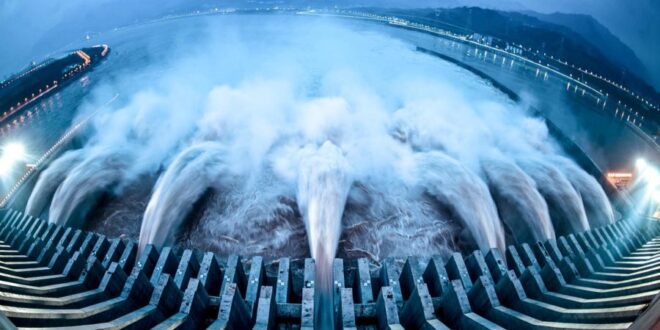Clean hydropower is produced in several parts of the world with around 60 percent coming from China, Brazil, the United States, Canada, Russia, India, Norway, Venezuela, Sweden, and Japan. Now, more countries want to exploit their hydropower potential as governments worldwide push for a green transition. However, the industry faces a multitude of challenges, mainly associated with climate change. Recent periods of drought in several countries around the globe have driven down hydropower production rates and threaten future output.
Hydropower is one of the oldest forms of renewable energy production. It uses the flow of water to power a generator and produce electricity. Companies traditionally place hydroelectric power plants on or near a water source. The volume of the water flow and the change in elevation from one point to another determines the amount of energy available in moving water. The greater the flow of water or the greater the elevation change the greater the quantity of electricity that can be produced.
There are two types of conventional hydropower operations. The first is the run-of-the-river system, which relies on the force of the river’s currents to power a turbine. Some of these operations use a weir to divert the water towards the turbines. The second is the storage system, which uses reservoirs created by dams on streams and rivers to collect water that can then be released through turbines, providing a high level of pressure. Pumped-storage hydropower facilities are an example of a less conventional hydropower system where water is pumped from the source to a storage reservoir higher up. The water can then be released from an upper reservoir to hydro turbines below. However, this process requires more electricity than conventional facilities.
The amount of available water greatly affects hydropower production. For example, the quantity of rainwater that drains into rivers and streams in any particular area determines the amount of water available for hydropower production. This varies by season and can also shift long-term as precipitation patterns change. Droughts, therefore, can have an extremely negative impact on hydropower production.
The energy analyst Ember believes around 8.5 percent of hydroelectricity generation loss is associated with droughts. This is most common in China, which accounted for around three-quarters of the global decline last year. China is the largest producer of hydroelectricity in the world in terms of capacity. The U.S. also experienced a six percent reduction in hydropower output last year. The U.S. Energy Information Agency said that it was largely due to “above-normal temperatures” rapidly melting the snow in the northwest of the country, where most hydroelectricity is generated. Although drought conditions improved in California, which helped it boost production levels.
As hydropower production has been falling in Canada it has become more reliant on the U.S. for energy imports, with U.S. electricity exports to Canada reaching their highest level since 2010 in March this year. A recent decrease in the amount of rain and snow in Canada has driven down production at its hydropower plants. While some are hopeful that this is a temporary phenomenon, climate experts believe that it could be owing to a long-term shift in weather patterns due to climate change. Chris O’Riley, the CEO of the British Columbia Hydro and Power Authority, stated, “We’ve all got to be humble in the face of more extreme weather… We manage from year to year the ups and downs of water, and when we have the downs like we’re having, the lower levels, it’s common for us to import power, and we expect to continue that this year.” Large hydroelectric facilities were once considered a stable source of electricity. However, in recent years, low reservoirs in California, around Hoover Dam and recently in Canada have made hydropower electricity production less certain.
The Middle East is experiencing a long-term decline in hydropower capacity due to widespread drought. The Euphrates-Tigris River basin is one of the fastest-drying regions on earth, meaning that both agriculture and electricity production in Turkey, Syria and Iraq are being hit hard. There has been around a 25 percent decrease in electricity generation at three hydropower dams in Turkey over the last 30 years. Dursun Yildiz, the president of the Turkish NGO the Hydropolitics Association, explained, the diminishing precipitation and snowfall is linked to climate change, and will ultimately lead to a 30 to 40 percent reduction in Euphrates River flows by the end of the century.
Meanwhile, in the African region, hydropower is the largest source of renewable energy on the continent, contributing almost one-quarter of the total electricity generation in sub-Saharan Africa. Several countries are more at risk than when it comes to a decrease in hydropower generation due to climate change, as they have few alternative energy sources available. These include the Democratic Republic of Congo, Ethiopia, Uganda, Zambia, Mozambique and Sierra Leone. This demonstrates the severe need for the development of a more diverse energy mix across the continent.
There is significant potential to develop more hydropower in several regions of the world, particularly in Africa. However, the worsening effects of climate change are threatening the previously reliable renewable energy source. If droughts happen more frequently, those countries affected will have a reduced hydropower capacity, meaning they may come to rely on alternative energy sources or energy imports from other countries.

This picture taken on July 24, 2012 shows water released from the Three Gorges Dam, a gigantic hydropower project on the Yangtze river, in Yichang, central China's Hubei province, after heavy downpours in the upper reaches of the dam caused the highest flood peak of the year. Weekend floods in Beijing caused "significant losses" and casualty numbers are still being tallied, the head of the worst-hit district has said, as residents of China's capital question the official toll. CHINA OUT AFP PHOTO (Photo credit should read STR/AFP/GettyImages)
 Iran Energy News Oil, Gas, Petrochemical and Energy Field Specialized Channel
Iran Energy News Oil, Gas, Petrochemical and Energy Field Specialized Channel



